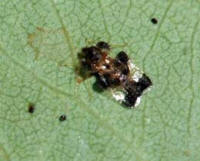|
Symptoms: These pests feed on the lower surface
of leaves and suck the juice out similar to
spider
mites
or leafhoppers. The leaves then give that mottled look
with speckles of yellow, gray or white mixed in with the
green
chlorophyll. Unlike those other insects, lacebug
feeding results in shiny, hard, black droplets of their
excrement that stick to the bottom of damaged leaves.
|
|
 Diagnosis:
Lacebugs feed on a number of trees and shrubs, however,
each species of the insect is specific to a species of
plant. The immature bug is small, light or dark, spiny
and wingless while the adult is brownish with clear,
lacy wings. Both types feed on the leaf. Diagnosis:
Lacebugs feed on a number of trees and shrubs, however,
each species of the insect is specific to a species of
plant. The immature bug is small, light or dark, spiny
and wingless while the adult is brownish with clear,
lacy wings. Both types feed on the leaf.
The mottling is, like
other sucking insects, caused by the loss of chlorophyll
due to the removal of sap from the leaf. The impact on
the plant is usually minimal except in the case of very
large populations of lacebugs. The damage is unsightly
and may result in a loss of vigor and energy in the
plant.
|



